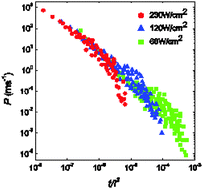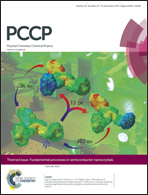Extension of the diffusion controlled electron transfer theory for intermittent fluorescence of quantum dots: inclusion of biexcitons and the difference of “on” and “off” time distributions
Abstract
The equations for the diffusion controlled electron transfer (DCET) theory of quantum dot blinking are extended to include biexcitons. In contrast to excitons, which undego resonant light to dark transitions, the biexcitons, having a much larger total energy, undergo a Fermi's Golden rule type transfer (many acceptance states). The latter immediately gives rise to an exponential tail for the light state, and it is explained why the dark state power law behavior is unaffected. Results are given for both continuous and pulsed excitation. The typical −3/2 power law for the light state at low light intensities, and for the dark state at all intensities, as well as dependence of the exponential tail on the square of the light intensity, and a decrease of the power in the power law for the light state from −3/2 to less negative values with increasing light intensity are all consistent with the theory. The desirability of measuring the dependence of the spectral diffusion coefficient on light intensity at room temperature as a test of several aspects of the theory is noted.

- This article is part of the themed collection: Fundamental Processes in Semiconductor Nanocrystals

 Please wait while we load your content...
Please wait while we load your content...